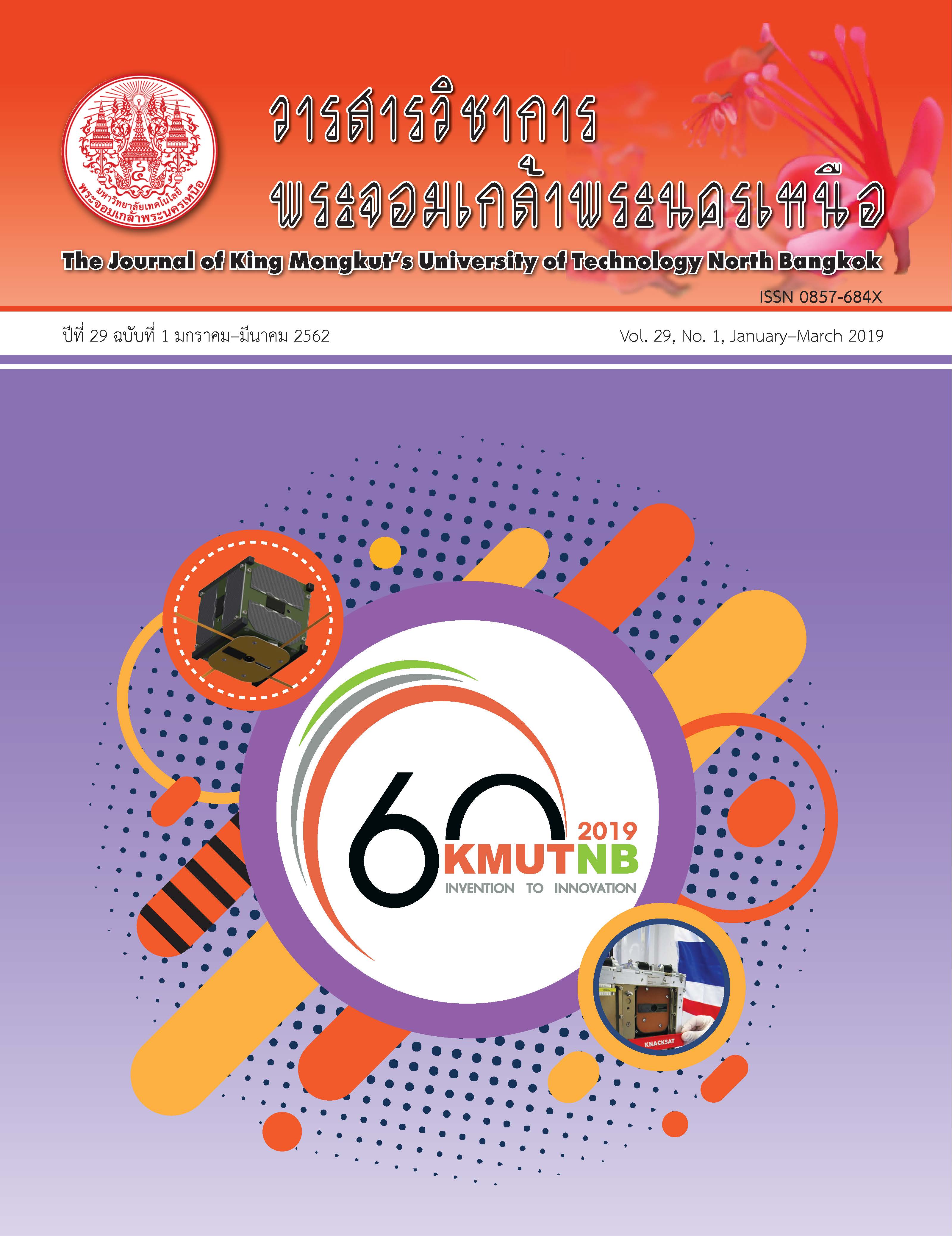การพัฒนาวิธีการทดสอบการเป่าโป่งด้วยน้ำเพื่อศึกษาอิทธิพลความไม่เท่ากันของโลหะแผ่นที่ระดับความเครียดสูงของเหล็กแผ่นคาร์บอนต่ำ
Main Article Content
บทคัดย่อ
ในกระบวนการขึ้นรูปโลหะแผ่นด้วยน้ำ ส่วนมากโลหะแผ่นจะถูกแรงกระทำภายใต้สภาวะแรงดึงสองทิศทาง (Biaxial) และมีการยืดตัวที่ค่าความเครียดมากกว่า 60% ส่งผลให้ค่าการทดสอบหาสมบัติของโลหะแผ่นที่ได้มาจากผลการทดสอบแรงดึงแกนเดียวที่ให้ข้อมูลความสัมพันธ์ระหว่างความเค้นและความเครียดในช่วงความเครียดที่ต่ำกว่า 30% ไม่สามารถใช้ในการออกแบบและศึกษาพฤติกรรมของการขึ้นรูปวัสดุได้อย่างเหมาะสม ดังนั้นจึงได้มีการพัฒนาการทดสอบคุณสมบัติโลหะแผ่นแบบเป่าโป่งด้วยน้ำ (Hydraulic Bulge Test; HBT) ขึ้นมาทดแทนโดยใช้แรงดันน้ำมาทำการขึ้นรูปโลหะแผ่นที่ถูกขึงตรึงให้เป็นรูปโดมครึ่งวงกลมจนกระทั้งชิ้นงานเกิดการฉีกขาด หลังจากนั้นจึงนำค่าความสัมพันธ์ระหว่างแรงดันกับความสูงของโดมที่เกิดขึ้น มาทำการหาความสัมพันธ์ระหว่างความเค้นกับความเครียด โดยกราฟความสัมพันธ์ระหว่างความเค้นและความเครียดที่ได้จากการทดสอบนี้จะรวมผลของค่าความไม่เท่ากันทุกทิศทุกทางของโลหะแผ่น (Anisotropy) ซึ่งส่งผลให้กราฟที่ได้จะมีค่าความเค้นที่สูงกว่าความเป็นจริง จึงจำเป็นต้องอาศัยการทดสอบแรงดึงแกนเดียวมาทำการหาค่าความไม่เท่ากันทุกทิศทุกทางของโลหะแผ่น แต่ค่าความไม่เท่ากันทุกทิศทุกทางของโลหะแผ่นที่หามาได้นั้น ยังอยู่ในระดับความเครียดที่น้อยกว่าระดับความเครียดที่เกิดขึ้นในการทดสอบ HBT ดังนั้นในงานวิจัยนี้จึงมุ่งเน้นในการพัฒนาการทดสอบแบบเป่าโป่งด้วยน้ำโดยการปรับสัดส่วนของรูปโดมทรงกลมและโดมรูปทรงวงรีในสัดส่วนต่างๆ กัน เพื่อให้สามารถเห็นถึงอิทธิพลของค่าความไม่เท่ากันทุกทิศทุกทางของโลหะแผ่นในระดับความเครียดที่สูงได้ โดยเริ่มจากออกแบบรูปร่างและรูปทรงแล้วทดสอบด้วยการจำลองการขึ้นรูปด้วยระเบียบวิธีไฟไนต์เอลิเมนต์ก่อน แล้วจึงมาทำการสร้างแม่พิมพ์ด้วยเทคโนโลยีการสร้างต้นแบบรวดเร็วแบบฟิวส์เดปโพซิชันโมเดลลิ่ง (Fuse Deposition Modeling; FDM) โดยใช้วัสดุที่ทำจากพีแอลเอ (Polylactic Acid; PLA) เนื่องจากการทดสอบคุณสมบัติของโลหะแผ่นใช้การทดสอบเพียงไม่กี่ครั้งทำให้เป็นการประหยัดเวลาและค่าใช้จ่ายในการทำแม่พิมพ์ ในการทดสอบจริงได้ทดสอบกับโลหะแผ่นคาร์บอนต่ำ SPCC ความหนา 1.0 มิลลิเมตร พบว่าแม่พิมพ์ที่ทำจาก PLA สามารถขึ้นรูปชิ้นงานในรูปทรงวงรีได้ โดยแม่พิมพ์ไม่เสียหายและยุบตัว นอกจากนั้นจากผลทางสถิติยังพบว่าที่ความสูงโดมเท่ากันที่ 21.48 มิลลิเมตร แรงดันในแนวรีดมีค่า 211.76 บาร์ และแรงดันในแนวขวางแนวรีดมีค่า 215.23 บาร์ ซึ่งมีความแตกต่างกันที่ 3.47 บาร์ ดังนั้นแม่พิมพ์ที่ออกแบบไว้สามารถแสดงอิทธิพลของค่าความไม่เท่ากันทุกทิศทุกทางของโลหะแผ่นได้
Article Details
บทความที่ลงตีพิมพ์เป็นข้อคิดเห็นของผู้เขียนเท่านั้น
ผู้เขียนจะต้องเป็นผู้รับผิดชอบต่อผลทางกฎหมายใดๆ ที่อาจเกิดขึ้นจากบทความนั้น
เอกสารอ้างอิง
[2] ASTM Standard E8/E8M-13: Standard Teat Method for Tension Testing of Metallic Materail, ASTM International, West Conshohocken, PA, 2013.
[3] ASTM Standard E517-00: Standard Teat Method for Plastic Strain Ratio r for Sheet Metal, ASTM International, West Conshohocken, PA, 2000.
[4] G. Gutscher, H. Wu, G. Ngaile, and T. Altan, “Determination of flow stress for sheet metal forming using the viscous pressure bulge (VPB) test,” Journal of Materials Processing Technology, vol. 146, no. 1, pp. 1–7, 2004.
[5] D. W. A. REES., “Plastic flow in the elliptical bulge test,” International Journal of Mechanical Sciences, vol. 37, no. 4, pp. 373–389, 1995.
[6] W. F. Hosford, R. M. Caddell, Metal Forming Mechanics and Metallurgy, Second Edition. New Jersey: PRT Prentice Hall, 1993.
[7] P. Hariharasudhan, “Determination od process parameters for stamping and sheet hydroforming of sheet metal parts using finite element method,” Ph.D. Dissertation, Department of Mechanical Engineering, The Ohio State University, Ohio, 2007.
[8] FDM tooling for sheet metal forming: Hydroforming and Rubber Pad, Technical application guide, Stratasys Incorporated, 2015.

